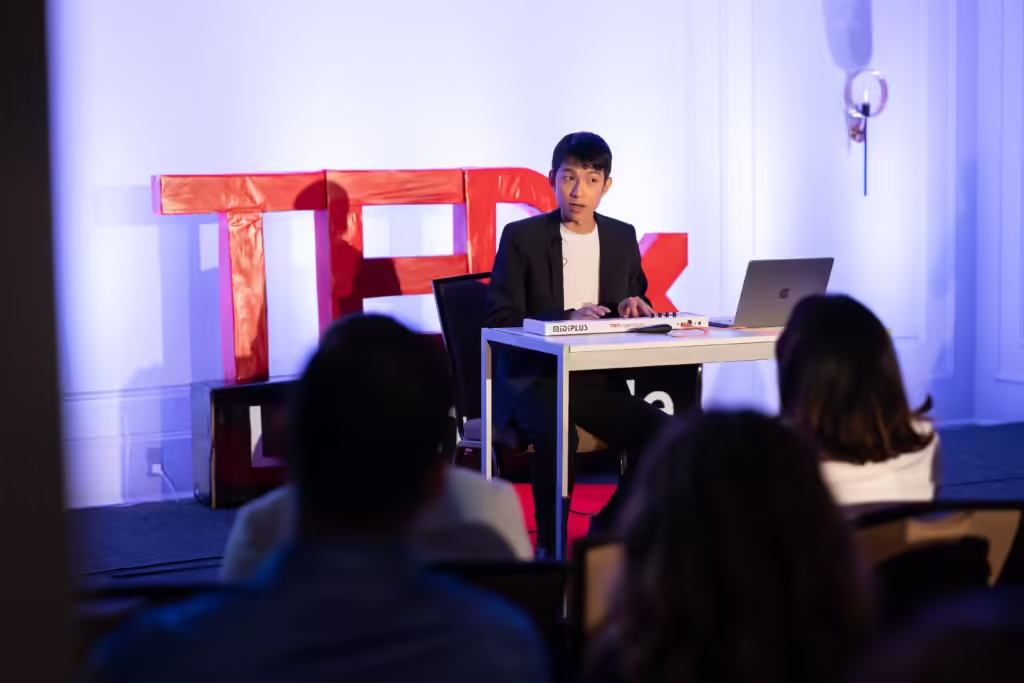Picture Credit: Tammy McConaty
Check out my TEDx talk by clicking here.
This is Episode 14 in my TEDx journey series. In case you missed them, here are the previous entries:
- Episode 1: My Secret to Becoming a TEDx Speaker: The Event Theme
- Episode 2: How I Became a TEDx Speaker: Getting The Acceptance Letter
- Episode 3: Why I Hated My First TEDx Talk Draft: What Was Missing
- Episode 4: Why My Second TEDx Draft Was Worse Than The First
- Episode 5: My TEDx Draft 3: Even Worse than Versions 1 and 2
- Episode 6: My TEDx Draft 4: How I Completely Overhauled My Talk
- Episode 7: How to Write a TEDx Talk You’re Proud Of: The Final Draft
- Episode 8: How I Rehearsed (Unconventionally) For My TEDx Talk
- Episode 9: What to Do The Day Before Your TEDx Talk: Master the Venue
- Episode 10: How I Freaked Out Right Before Giving My TEDx Talk
- Episode 11: The Gamble I Took with My TEDx Opening Story
- Episode 12: The Number One Tip for Writing a TED Style Talk
- Episode 13: When Things Go Wrong During Your TEDx Talk: 3 Pro Tips
The most frustrating movie of all time for me is “Star Wars: Empire Strikes Back”.
Absolutely beloved by fellow fans, I don’t like the ending:
- The main character gets defeated by the villain and the movie ends with him looking out into the distance, contemplating the future.
How could it end like that?
More contemporary example: “Spiderman: Across the Spiderverse”:
- The main character also gets defeated and the movie ends with his friends looking out into the distance, contemplating the future.
…
The reason those endings are so frustrating is they’re cliffhangers! They don’t tie up all the compelling elements from before and the story doesn’t resolve.
(Now, that’s a bit unfair because these movies are the second in a trilogy – resolving things is what the third film is supposed to do…)
So this actually isn’t a critique. It’s a lesson about story:
The fact I was frustrated means these movies did a good job of making me emotionally invested.
For presentations the same applies: you need to make your audience so emotionally invested in hearing the conclusion that they look forward to seeing your satisfying sendoff.
In this article I will overview the number one key to a great presentation conclusion.
Our previous articles overviewed the “core idea of change”. A presentation is about going from a place of pain, problem, or challenge, and changing – transforming – to a place of resolve, solution, and overcoming.
Another way of looking at it is going from a question you pose at the beginning:
- (Will sales keep going down? How do we stand out as introverts in the workplace? How do we communicate data in an engaging way?)
To answering it at the end:
- (With this solution sales can go back up. We can stand out as introverts by sharing thoughts in other ways. We can make data engaging by treating it like music).
And if the question is emotionally relevant to the audience, they will actively crave its answer.
But note this distinction:
- Good presentation conclusions give the answer
- Great presentation conclusions give the answer in an unexpected way
Here’s why that’s important scientifically:
Dopamine
Dopamine is one of the chemicals that governs your attention1
When we set a goal, our brain releases dopamine to make us crave achieving it.
That’s why we go get food when we’re hungry, and why we struggle to train for a marathon when it hurts every day.
But there’s a twist:
When you achieve the goal, you get a surge of dopamine if it’s more than you expected.2
- Recall the feeling of finally eating and it being REALLY good, or finally running a marathon and getting FIRST PLACE.
But if it’s less than expected, dopamine drops:
- Imagine finally eating and it being disgusting, or finally running and getting last place.
To make your conclusion soar, you need to not just summarize everything in the presentation (which gives people exactly what they heard before), but tie it together in a novel way.
That surprise is what triggers the final dopamine surge and leaves the audience on a high
As an example, this was the core idea of change in my talk for TEDx Logan Circle: we can change data communication from dry and boring to compelling and engaging by making it more emotionally intuitive
I talk about:
- How I failed as a composer because I didn’t tap enough into emotion
- How I saw data presentations struggle to engage for the same reason
- And how we can make data presentations more musical by adding context and narrative
Note the build and build and build as those points progress …
Then imagine I end with:
“So what we learned today was I failed as a composer because of X and data presentations struggle because of Y and data presentations can be more exciting because of Z”
Immediately would have lost the audience and soured my hard-earned momentum
Instead, I summarize my points from a different perspective, expanding the talk’s scope outside music and data so the core lesson could resonate for members of any discipline.
This was the first line of my conclusion:
“Even if you don’t work with music and data, I invite you to consider the way you see the world”
I go on to explain how leaders, doctors, and professionals of any field best succeed when they balance emotional intuition/experience with logical, data-driven analysis.
With this angle, I could solidify the talk’s core idea of change, but in a way that was more widely applicable than expected.
Remember: to end a talk on a literal high note and engage dopamine effectively, you must do more than just a basic summary
Find a way to connect all the dots you’ve laid out in a new, exciting way:
- Perhaps a bigger scope
- Perhaps a practical call to action
- Perhaps a personal story that exemplifies your top points
Whatever you choose, be sure that it not only highlights what you said, but elevates it so it’s undeniably memorable.
Coming up next in the series is Episode 15: “How Giving a TEDx Talk Changed My Life”...
Before getting to the end of the series, you can also check out the TEDx talk below!
Sources
1 Fast Company, “Why you love setting goals more than pursuing them, according to science”
2 National Library of Medicine, “Dopamine reward prediction error coding”



